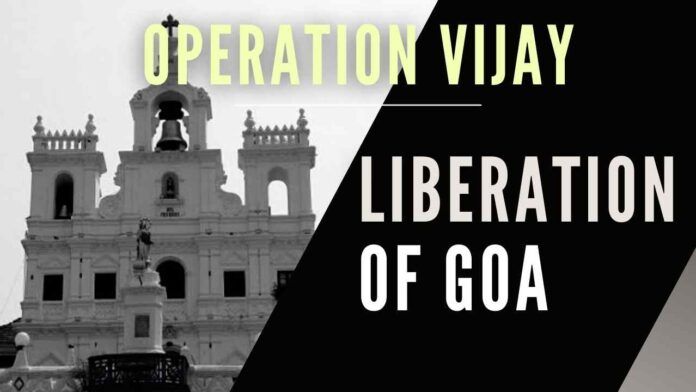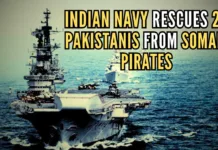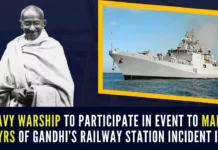
A 40-hour ‘Operation Vijay’ that changed the history Of Goa
Goa celebrates its Liberation Day with an abundance of events and festivities. The Indian troops reclaimed the Goan territory on December 19 with little resistance and the deposed governor-general Manuel António Vassalo e Silva signed the certificate of surrender thus bringing Portuguese rule in the region to an end.
Goa Liberation Day is a mark of the success of ‘Operation Vijay‘ undertaken by the Indian Armed Forces that liberated Goa from Portuguese rule.
Officially, India intervened militarily in Goa on December 11, 1961, after it had become evident that the economic blockade that had been in force against the colony since 1955 had not worked, and the Portuguese administration was getting increasingly repressive.
All three sections of the Indian armed forces participated in Operation Vijay. The Indian attack overpowered the Portuguese 3,000-member army with a force of almost 30,000.
The Portuguese ruled Goa after they captured it from the Marathas in 1641. The freedom struggle in India had its effects on a smaller scale in Goa as well. Goans participated in Satyagraha in the late 1940s. After India got independence, the Portuguese refused to give up their hold over Goa.
The igniting spark was the incident in November 1961, when the Portuguese contingent based at Anjadip island, off the coast of Canacona, fired at the Indian merchant ship Sabarmati in a display of its maritime supremacy in the region.
The Portuguese garrisons resorted to indiscriminate firing on Indian fishing boats off Karwar (in present-day Karnataka) and South Goa. As a result, two Indian naval ships — Rajput and Kirpan — were deployed on patrol to escort merchant shipping traffic and ensure the safety of the fisherfolk.
As a result, On December 1, 1961, Operation Chutney, the precursor to Operation Vijay, was initiated by the Naval Headquarters to capture Anjadip. Indian Navy ships Betwa and Beas were deployed on linear patrol off Goa, and the Mysore and Trishul prepared to carry out an amphibious landing operation with a platoon of 75 sailors. They were led by Lieutenant Arun Auditto and Senior Commissioned Gunner N Kelman.
INS Trishul on Dec 18, 1961, set the operation underway. According to the plan, the platoon was to land in two waves on a beach that was 3 km south of the main Portuguese garrison. Just before the first wave left INS Trishul, a large white flag of surrender was hoisted by the Portuguese on the island’s northern edge.
The first wave landed uneventfully on the beach as planned, they swayed the white flag as a mark of peace, followed by a second group that approached the island directly. The Portuguese fired machine gunfire at them which left Indian naval boats with bullet holes.
A full-fledged gun and grenade battle started between the Indian and Portuguese soldiers for control over Anjadip. The first group under Lieutenant Arun Auditto proceeded as planned to capture the garrison on the northern ridge overlooking the town. INS Trishul opened fire on the north-western ridge.
The ferocity of the fire with which the Indian naval ship responded forced the well-entrenched enemy garrison to surrender. The INS Trishul was then joined by the INS Mysore. Jointly, they directed their firepower on the northern part of the island from the south-east (Mysore) and south-west (Trishul). The Portuguese were outmatched and they surrendered.
The Indian Tricolour was hoisted on Anjadip at 2:25 p.m. on December 18, 1961.
Although we lost 7 sailors in the battle; two officers and 17 sailors were wounded.
Lt. Auditto, the leader of the first assault team was decorated with the Navy Medal (Gallantry). Senior Commissioned Gunner Neol Kelman, in spite of being hit by a bullet through his thighs, made light of his wounds and continued to assist in the operations till the Tricolour was hoisted. He was awarded the Kirti Chakra.
Even as the battle at Anjadip was in progress, the Indian Army and Air Force began closing in on Goa. Offensive action started with four IAF Canberra bombers strafing the Dabolim airfield on December 18.
On December 18, 1961, the Indian Navy hoisted the Tricolour in the island of Anjadip off Canacona for the first time in the history of the last colonial outpost in the country.
That was the beginning of the end of 451 years of Portuguese rule over Goa, Daman, and Diu.
The high point of Operation Vijay was a 13-minutes gun duel between the Portuguese man of war, Afonso de Albuquerque, and the Betwa, Beas, and Cauvery. On being ordered by the Naval Headquarters to capture the Portuguese warship, INS Betwa signalled its intentions to INS Beas and INS Cauvery.
Albuquerque was sighted, encircled, and directed to surrender in three minutes. As Albuquerque was non-compliant and tried to take cover behind a merchant’s vessel, Betwa and Cauvery started firing. After an intense gun battle, Albuquerque hoisted a white flag, turned towards the harbour, and beached on the Dona Paula jetty. Thus ended the first gun battle.
On December 18, the Indian Army came under intense gunfire from them. The land battle continued with INS Delhi being tasked to provide gunfire support with its 6-inch guns and open a seaward combat front.
The next 15 minutes saw 11 broadsides with a relentless volley of 66 6-inch high-explosive shells bombarding the citadel and the airfield in succession till a white flag was hoisted by the Portuguese.
As the army units were expected to take time to reach the Old Fort area, a landing party from INS Delhi was dispatched and the Tricolour hoisted in the Old Fort.
Operation Vijay ended in less than 40 hours, with the last Portuguese Governor-General, Antonio Vassalo e Silva, signing the Instrument of Surrender at 8:30 p.m. on December 19. The Indian armed forces, acting in unison, rightfully restored Goa to motherland India.
[With Inputs from IANS]
PGurus is now on Telegram. Click here to join our channel and stay updated with all the latest news and views
For all the latest updates, download PGurus App.
- UP Special Task Force arrests Mahadev app India head, his associate from Lucknow - April 26, 2024
- CBI raids Sheikh Shahjahan’s relative in Sandeshkhali; seizes huge cache of arms, explosives - April 26, 2024
- Will ‘exit India’ if forced to break encryption: WhatsApp to Delhi High Court - April 26, 2024










